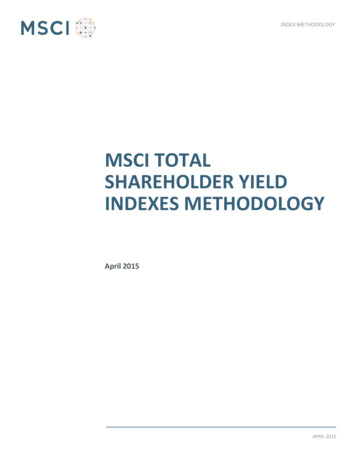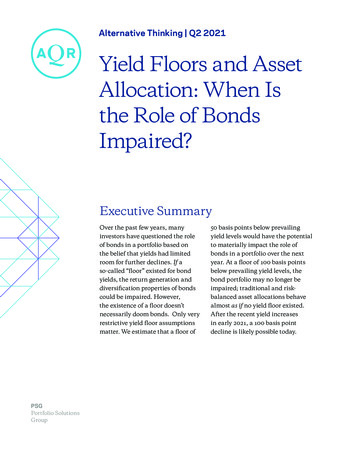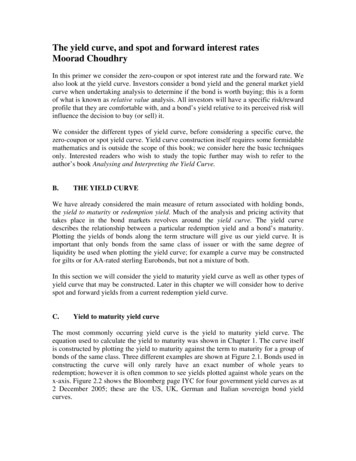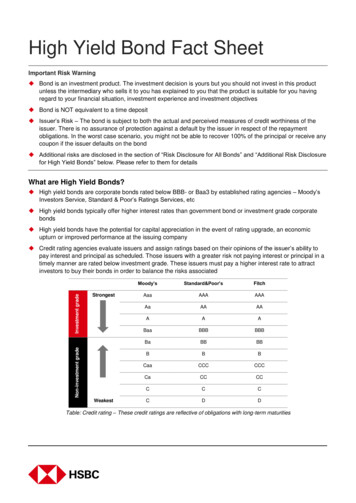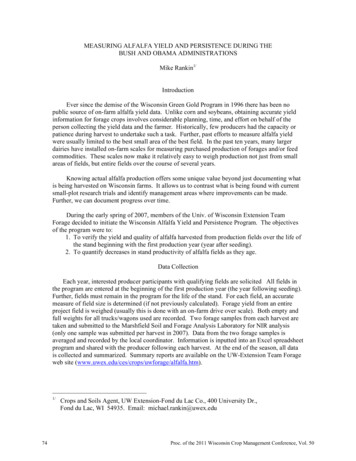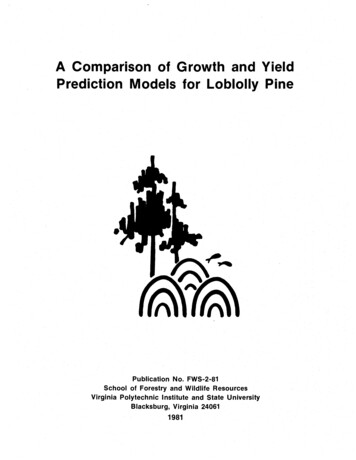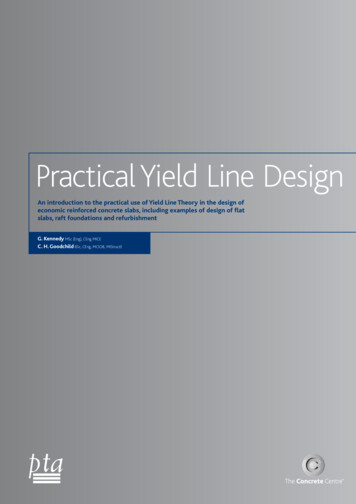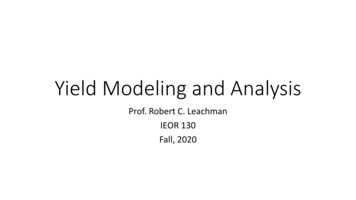
Transcription
Yield Modeling and AnalysisProf. Robert C. LeachmanIEOR 130Fall, 2020
Introduction Yield losses in wafer fabrication take two forms: line yield and die yield. Line yield losses include physical damage to the wafers from mis-handlingand mis-processing (e.g., skipping or duplicating a process step, wrongrecipe, equipment-out-of-control). Mis-processing is detected either by in-line inspections interspersedthrough the wafer fabrication process or by an electrical parametric test ofa special test pattern on the wafer. This parametric test is almost always performed just before the wafer leavesthe fabrication facility to go to the wafer probe area. It is also sometimesperformed at one or more points within the wafer fabrication process flow.
Introduction (cont.) Many die yield losses are the result of tiny defects. Defects are defined asany physical anomaly that causes a circuit to fail. This includes shorts orresistive paths or opens caused by particles, excess metal that bridgesacross steep underlying contours causing shorts, photoresist splatters andflakes, weak spots in insulators, pinholes, opens due to step coverageproblems, scratches, etc. In some companies, this is called contamination. It is natural to think of defects as being randomly distributed across thewafer surface, and to speak about the density of defects on the wafersurface, i.e., the number of circuit faults per unit area. If we postulate thata die will not work unless it is completely free of defects, then theprobability that a die works is the probability that no defects lie within itsarea. Obviously, the larger the die area, the more the chance it includes one ormore defects, and so the less the probability that the die works.
Introduction (cont.) Thus wafers with large die printed on them will have a lower die yield thanwill wafers with small die printed on them, if the two types of wafers aremade in the same fabrication process and are subject to the same densityof defects. To fairly compare die yields of products with different die areas made indifferent factories, it is desirable to find the underlying defect density ineach factory. A factory with a lower defect density is capable of producingwith a higher die yield. Not all die yield losses are due to defects. Some mis-processing escapesdetection at in-line optical inspections in the fabrication process as well asat parametric test. And some types of mis-processing affect only a portionof the dice printed on the wafer.
Introduction (cont.) A prevalent example of die yield loss that is not the result of contaminationis edge loss. The thickness of films deposited on the wafer is often wellcontrolled across the central portion of the wafer but poorly controllednear the edge of the wafer, resulting in wholesale die yield losses near theedge. Parametric test and in-line inspections typically are performed on asample basis and exclude edge die. Hence edge losses show up as die yieldloss, even though they are not the result of defects. For the moment, we will assume all die yield losses are the result of defectsin order to develop the theory of defect density models. We will relax thisassumption subsequently.
The Poisson Model Suppose the mean number of defects per die is λ0. According to thePoisson probability distribution function, the probability that a die has kdefects is given byke λ0 λ 0P(k ) , for k 0, 1, 2, k! The probability the die works is P(0); the expected die yield is thereforeDY P(0) e λ0 . If the mean defect density is D0 defects per square centimeter, and the diearea is A sq cm, then we should take λ0 D0A. We therefore writeDY e D0 A . This is called the Poisson die yield model.
The Poisson Model (cont.) Given an observed die yield DY for a product with die area A, we can inferthat the underlying defect density in the fab isln DY.D0 A A very useful feature of the Poisson model is the additivity of defects. If theoverall defect density D0 is decomposable into defectivity contributions atdifferent steps or different mask layers, e.g.,D 0 D 1 D 2 D 3 Dn ,then the yield loss contribution of each step or layer is easily identified, asthe overall die yield has a product form:DY e AD0 e An Dii 1n e ADi .i 1
The Poisson Model (cont.) Using this product form, one can calculate the yield improvement to begained from reductions in defect density achieved at various steps orlayers. For example, if the defect density in layer j is reduced from Dj to Dj – Dj, then the new die yield isDYNEW eA D jn ADie e A D jDY .i 1 Empirically, the Poisson yield model has been found to give accurate yieldpredictions for small die (when A 0.25 sq cm) and when the expectednumber of defects per die is low (when D0A 1.0). In the case of large dieareas, it tends to underestimate die yield, for reasons that will be explainedlater. Nonetheless, in almost any situation, it is accurate for estimatingsmall changes in die yield as a function of small changes in step-level orlayer defect densities.
The Binomial Model Suppose the entire wafer has n total defects on it. Let p be the probability thata random defect lands on a given die. Assume the defects are independentfrom each other. According to the binomial distribution, the probability that kout of the n defects land on the particular die in question isn!P(k ) p k (1 p ) n k .k!(n k )! In particular, the probability the die works isP(0) (1 p ) n . Suppose the area of the whole wafer is Aw, and suppose the area of the die isA. If the defect density is D0, then the expected total number of defects on thewafer is n D0 Aw, while the expected number of defects on a die is D0A. Theprobability a particular defect is located within a given die is just the ratio, i.e.,𝐷𝐷0 𝐴𝐴𝐴𝐴𝑝𝑝 .𝐷𝐷0 𝐴𝐴𝑤𝑤 𝐴𝐴𝑤𝑤
The Binomial Model (cont.) Substituting into our expression for P(0), we have𝐴𝐴𝐷𝐷𝐷𝐷 𝑃𝑃 0 1 𝐴𝐴𝑤𝑤𝐷𝐷0 𝐴𝐴𝑤𝑤. Typically, the area of the wafer Aw is much larger than the area of the die A.Moreover,D0 Awlim A 1 e D0 A .Aw Aw For Aw an order of magnitude larger than A, the top expressionclosely approximates exp(-D0A). Thus the Binomial model givesessentially the same numerical answers for die yield as does thePoisson model. Since the Poisson model is mathematically moretractable, it is used in preference.
Mixed Distribution Models Actual data on defects shows that defect and particle densities vary widelyfrom chip to chip, from wafer to wafer, and even from lot to lot. In fact, thedefects frequently tend to cluster together. Because of this, the Poissonmodel tends to underestimate die yield when the expected number ofdefects per chip is greater than one or when the die area is relatively large.(When the defects cluster together in some die, then other die can berelatively defect-free, thereby increasing the yield compared to the casewhen defects are more spread out.) One approach for dealing with this problem is to posit that the defectdensity D itself varies according to a probability distribution f(D). This wasfirst done by B. T. Murphy of Bell Labs. The expected die yield in this case isexpressed as DY e DA f ( D)dD .0
Mixed Distribution Models (cont.) By definition, the distribution f(D) has mean D0, but beyond that, we don'thave much of an idea as to what it should look like. If one assumes D isdistributed uniformly between 0 and 2D0, the previous integral expressionsimplifies to 2 AD1 eDY 2 AD00. If one assumes D is distributed according to a symmetrical triangulardistribution extending from 0 to 2D0 with peak at D0, it can be shown thatthe integral simplifies to2 AD 1 e 0 DY . AD0 This expression is commonly referred to as the Murphy model for die yield.Given a die yield DY and the chip area A, one can numerically solve for D0.
Mixed Distribution Models (cont.) If one assumes D is distributed according to an exponential distribution,i.e.,D1 D0f ( D) e,D0it can be shown that the integral simplifies toDY 1,1 AD0which is known as the Seeds model for die yield.
Mixed Distribution Models (cont.) A variant of the Seeds model, known as the Bose-Einstein model for die yield,is a product formn 1 ,DY 1 AD0 where n is the number of critical mask layers. The idea behind the Bose-Einsteinmodel is that most fatal defects are deposited in certain difficult (“critical”)mask layers. For example, metal layers are especially prone to the generation offatal defects. We would expect that a device fabricated in a process technologywith a given number of critical layers (say, four metal layers) will have a lowerdie yield than a device with the same area fabricated in another technologywith fewer critical layers (say, two metal layers).The Bose-Einstein model can be developed assuming die yield in each criticallayer is expressed using the Seeds model, and overall die yield is the product ofdefect-limited yields in all the critical layers.
Mixed Distribution Models (cont.) If f(D) is assumed to be a Gamma distribution, it has been shown that theintegral reduces to a Negative Binomial model, i.e.,AD0 DY 1 α α,where α is called the cluster parameter. If defect data is available, thisparameter can be estimated from the defect data asα (σλ22 λ).Here, 𝜆𝜆̅ is the mean number of defects per die and σ is the standarddeviation of the number of defects per die.
Mixed Distribution Models (cont.) By suitably choosing the extra parameter α, the Negative Binomial modelcan closely approximate any of the other defect density models. For 𝛼𝛼 10, the Negative Binomial model is essentially the same as thePoisson model. For α 5, the Negative Binomial closely approximates theMurphy model. For α 1, the Negative Binomial closely approximates theSeeds model. A drawback to using the Negative Binomial model for determining defectdensity is that given only a die yield DY and a die area A, it is not clear whatvalue of α to use in order to determine the underlying mean defect densityD0. If α were somehow given, the mean defect density can be easilycomputed as1D0 α DY A α 1 .
Practical Defect Density Models For small die sizes A 0.25 sq cm, or for low defect densities AD0 1, thesimple Poisson model (2) is widely used and is accurate. Moreover, if one isonly concerned about the change in die yield given a change in defectdensity at one or several process steps, an analysis using the Poisson modelis sufficiently accurate. For large die sizes, the Negative Binomial model is the most flexible andpotentially most accurate model. However, the extra parameter α needs tobe determined by statistical methods or by estimation from actual defectdata. Where such data are not available, the Murphy model is frequentlyused.
Models Incorporating Both Random andSystematic Yield Losses Now suppose that in addition to random defects there are lossesindependent of die size that we shall term systematic yield losses. Wedecompose overall die yield as DY YSYR, where YR is the defect-limitedyield and YS is the systematic-limited yield. If we posit a simple PoissonModel for defects, we haveDY YS YR YS e AD0 . Using linear regression, we can determine a best fit of the two parametersYS and D0 to actual data on DY vs. A if we take logs of both sides of theabove equation:ln DY ln YS AD0 .
Models With Random and Systematic Yield Losses(cont.)ln DY ln YS AD0 . Here, ln YS is the constant and D0 is the coefficient on the independentvariable A. If we had die yield data for many different-sized productsproduced in the same fab, we could compute least-squares regressionestimates of ln Ys and D0. But suppose there is only one product being produced. As explained infollowing slides, we can determine these unknown parameters from wafermap data for the product using what is known as the windowing technique. A wafer map presents the yield by die position on the wafer. An example ofa stacked wafer map, showing the average yield by die position for manywafers of the same product, is depicted in Figure 1.
Figure 1. Sample Wafer Map
Models With Random and Systematic Yield Losses(cont.) The windowing technique is explained as follows. The average die yield forthe product vs. the die area of the product constitutes one data point. Nowsuppose we group the dice printed across the wafer surface into pairs, andpretend that the pair is a single die with area 2A. This paired single-die onlyworks if both component dice work. From review of the wafer map, the dieyield of this paired single-die can be identified. This provides a second datapoint. The procedure can be repeated for die groups of size 3, 4, 5, 6, 7, 8,etc., providing more data points for the regression. Just as for the simple Poisson model for defect density, any of thecompound defect density models could be appended with a systematiclimited yield coefficient YS. In practice, a two-parameter model such as thesimple Poisson with a systematic-limited yield coefficient is typicallysufficient for practical purposes.
Models With Random and Systematic Yield Losses(cont.) We remark that the windowing technique simply sorts out yield losses intothose that are independent of die area versus those that are dependent ondie area. This is not equivalent to a decomposition of yield losses by pointdefect mechanisms vs. systematic mechanisms. For example, edge losseswill be larger for wafers with larger-sized dice printed on them than forwafers with small dice. Thus losses from some of the non-defectmechanisms such as edge loss would end up being accounted for in the D0parameter rather than in the YS parameter. So to sort out truly random defect losses from losses stemming fromsystematic mechanisms, we need a different approach
Models With Baseline Random and SystematicYield Losses A different and useful decomposition of die yield stems from an SPC-typeviewpoint. Suppose we posit that the truly random die yield losses all mustcome from a stable, stationary system of chance causes that we classify asbaseline defects. There may be occasional excursions (significant additional yield losses fromthis baseline) when the process or equipment drifts out of control, eithermisprocessing or depositing excessive particles. Losses from such excursions,as well as chronic losses that are not randomly distributed, are termedsystematic yield losses. Systematic yield losses have an observable signature. It could be a signatureover time (e.g., one or several lots with exceptionally poor yields), or a spatialsignature (e.g., certain die positions on the wafer or certain wafer positionswithin the lot with much lower-than-average yields). Edge loss is a goodexample of a systematic yield loss with a spatial signature.
Models With Baseline Random and SystematicYield Losses (cont.) Suppose we abstractly collect all systematic losses into a single term 1-YSand all random losses into a single term 1-YR. (YS is known as the systematiclimited yield, YR is the baseline defect-limited yield.) The overall die yield isDY YRYS. Improvement of baseline yield requires fundamental improvement in thecleanliness of the process and equipment. Improvement of systematic yield requires improved process executionand/or improved process monitoring and control (to detect excursionsfrom baseline losses and react to contain losses from such excursions). Typically, faster progress in yield improvement can be made on thesystematic side, whereby signatures can be analyzed to help determineroot causes and to help devise and carry out engineering projects tomitigate specific systematic yield losses.
Models With Baseline Random and SystematicYield Losses (cont.) It is therefore helpful to know the YR vs. YS breakdown of overall die yield,as well as the breakdown of 1-YS into its many component losses. Some insight for the decomposition of yield into YR and YS components maybe gained by viewing a wafer yield histogram in addition to the wafer yieldmap. An example wafer yield histogram is presented in Figure 2. From alarge sample of wafers, the number of good die per wafer vs. the numberof wafers achieving that yield is plotted.
6050No. of wafers403020100Yield (%)Figure 2. Example of Yield Histogram
Models With Baseline Random and SystematicYield Losses (cont.) If yield losses were solely due to the stable system of chance causes, thenby the Central Limit Theorem, the histogram should present a normaldistribution. But it has a long left tail, indicating there are significantexcursion losses. The overall histogram reflects a juxtaposition of the normal distribution forthe baseline losses plus the excursion and systematic mechanism losses. If yield losses were solely due to stationary random baseline defects, onthe wafer map we should see a Poisson distribution of yield losses, which,for a large number of die per wafer such as in Figure 1, should look like anormal distribution. There should be no spatial correlation of yield acrossthe wafer. But that is not what we see. Note the poor edge yield and thepoor yield in the dead center of the wafer; those are clearly systematicproblems.
Figure 1. Sample Wafer Map
Models With Baseline Random and SystematicYield Losses (cont.) Suppose we looked at a wafer map developed solely from wafers that to the bestof our knowledge were not involved in any excursions. Suppose we focus on thebest-observed-yielding die site in that map, probably located near the center ofthis wafer map. We will certainly ignore the die sites near the edge that exhibitedge losses, and we will ignore the poor-yielding die site in the center of the mapin Figure 1, as well as any other die sites exhibiting a spatial signature. In Figure 1,the best-yielding die site exhibits a die yield of 54%, and there is only one die siteachieving this yield. For baseline random defects, die yield is well-characterized by a Binomialdistribution. (Recall that a Poisson model and a Binomial model are equivalentwhen the number of die per wafer is sufficiently large.) For Binomial die yield, thedistribution exhibited by the wafer histogram should be a normal distribution, ifthe wafer sample is sufficiently large. For such a distribution, a span of 6σ shouldcontain (almost) all observations and the peak should be centered 3σ from themaximum die yield.
Models With Baseline Random and SystematicYield Losses (cont.) The overall yield distribution as seen in Figure 2 is a juxtaposition of thebaseline random defect-limited yield and the systematic mechanisms-limitedyield. We might expect that excursions add a long left-hand tail, while chronicsystematic losses (such as edge losses) shift some of the distribution to theleft. We can argue that the only time the best-observed yield is achieved is whenno systematic losses are present and we are witnessing a point that is at theright-hand edge of the (unseen) normal distribution for the baseline randomyield. We therefore could expect the distance between the mean of thebaseline random yield distribution and the maximum die yield identified on astacked wafer map to be approximately 3σ of the distribution that resultsfrom the baseline random defect-limited yield, as long as the number of dieper wafer is sufficiently large. We can use this observation to estimate YR asfollows.
Models With Baseline Random and SystematicYield Losses (cont.) For a Binomial model with mean YR, the standard deviation of the averageyield is given byσ YR (1 YR ) / mwhere m is the total number of wafers in the stack. Let MY denote themaximum die yield that is observed. The difference between MY and theunknown YR depends on the number of die sites that were considered and athow many die sites MY was observed. For example, suppose there were 300die sites considered (die sites subject to edge loss or other chronicsystematic loss mechanisms are ignored), and suppose MY was observed at 2die sites. Using a normal approximation, that would suggest MY occurred atΦ -1(1-2/300) standard deviations above YR where Φ denotes the cumulativestandard normal density function.
Models With Baseline Random and SystematicYield Losses (cont.) More generally, if we apply the normal approximation so that the distance fromYR to MY is Φ -1(1 – l/n)σ, where l is the number of instances MY appears on thestacked wafer map and n is the number of die sites considered on the stackedwafer map, then we estimate MY occurs at YR kσ where k Φ -1(1 – l/n)σ. In particular, if MY were observed at 2 out of 88 die sites, that would suggest thatMY is two standard deviations above YR, and if MY were observed at 1 out of 714die sites, that would suggest that MY is three standard deviations above YR. Using this approximation, we haveMY YR kσ Φ 1 (1 l / n ) YR (1 YR ) / mwhich may be solved using the quadratic formula to find YR. Once YR is determined,we can divide it into DY to determine YS .
Models With Baseline Random and SystematicYield Losses (cont.) This binomial-sigma method will result in a smaller systematic mechanismlimited yield than the YS term computed using the windowing method. The virtue of this approach to match maximum-observed-yield is that edgelosses and defect excursions are excluded from the determination of YR (tothe extent that they do not contribute to the die sites exhibiting maximumyield). That is, defect losses are sorted out into baseline losses present across alldie sites on every wafer vs. other losses with a spatial or temporalsignature.
Figure 1. Sample Wafer Map
Models With Baseline Random and SystematicYield Losses (cont.) As an example, the wafer map in Figure 1 provided the average yields bydie site over a large group of wafers, in this case, 755 wafers. As for candidate die sites, we ignore the top three rows of dice, seeminglysubject to some systematic mechanism. Starting in the fourth row andignoring the edge die subject to edge loss, we have one row of 15, one rowof 17, two rows of 19, then 10 rows of 21, 2 rows of 19, one row of 17, onerow of 15, one row of 13, and one row of 9, ignoring the bottom rowsubject to edge loss. This makes for a total of 372 candidate die sites forobserving the maximum die yield. The maximum observed die yield is 57%, occurring at only one site out ofthe 372 candidate die sites. Then k Φ -1(1 – 1/372) 2.78. Solving thequadratic equation, we obtain the estimate YR 51.8%. The average dieyield is 43.1%, implying YS 83.2%.
, then the new die yield is Empirically, the Poisson yield model has been found to give accurate yield predictions for small die (when A 0.25 sq cm) and when the expected number of defects per die is low (when D 0 A 1.0). In the case of large die areas, it tends to underestimate die yield, for reasons that will be explained later.
